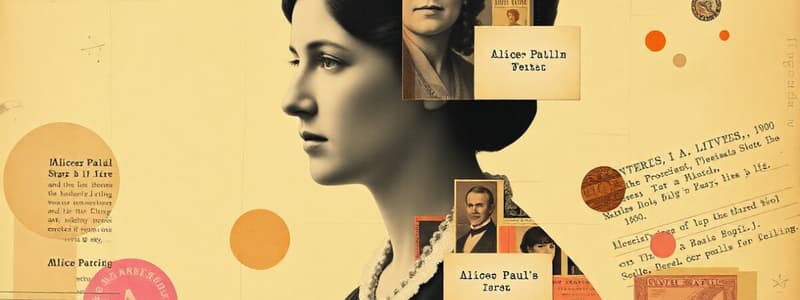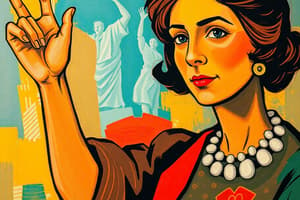Podcast
Questions and Answers
Which of the following accurately describes Alice Paul's upbringing?
Which of the following accurately describes Alice Paul's upbringing?
- She was raised in a strict, religious household. (correct)
- She was raised in a large, bustling city.
- She was raised in a family of Irish Catholics.
- She had a very active, outdoor lifestyle.
- She was raised in a home where political activism was common.
What prompted Alice Paul's shift from social work to political activism?
What prompted Alice Paul's shift from social work to political activism?
- She was inspired by a lecture by Christabel Pankhurst.
- She felt a strong personal call to fight for women's suffrage.
- She was influenced by her mother's involvement in suffrage meetings.
- She felt that her social work was not effective in bringing about change. (correct)
- She witnessed the hardship endured by the poor in New York City.
What does the text reveal about Alice Paul's personality?
What does the text reveal about Alice Paul's personality?
- She was a fervent and determined activist. (correct)
- She was a compassionate and empathetic individual.
- She was a rebellious and confrontational figure.
- She was a reserved and introspective individual.
- She was a quiet and obedient young woman.
What is the significance of the text's comparison of Alice Paul's childhood to her later life?
What is the significance of the text's comparison of Alice Paul's childhood to her later life?
What can we infer about Alice Paul's early interest in social justice?
What can we infer about Alice Paul's early interest in social justice?
What does the text suggest about the historical significance of Alice Paul?
What does the text suggest about the historical significance of Alice Paul?
What is the significance of Alice Paul's decision to leave social work?
What is the significance of Alice Paul's decision to leave social work?
What is the main idea of the text?
What is the main idea of the text?
What does the text suggest about the broader context of the women's suffrage movement?
What does the text suggest about the broader context of the women's suffrage movement?
What organization did Alice and Lucy form?
What organization did Alice and Lucy form?
What was the response of Ida B. Wells-Barnett to Alice Paul's order during the 1913 suffrage parade?
What was the response of Ida B. Wells-Barnett to Alice Paul's order during the 1913 suffrage parade?
What year was the Equal Rights Amendment, authored by Alice Paul, first written?
What year was the Equal Rights Amendment, authored by Alice Paul, first written?
What was the outcome of the Equal Rights Amendment after it was approved by Congress?
What was the outcome of the Equal Rights Amendment after it was approved by Congress?
What actions did Alice Paul take to protest outside the White House?
What actions did Alice Paul take to protest outside the White House?
What significant civil rights action did Alice and the suffragists achieve?
What significant civil rights action did Alice and the suffragists achieve?
What did Alice Paul suffer during her imprisonment for her activism?
What did Alice Paul suffer during her imprisonment for her activism?
How did Alice Paul celebrate the granting of suffrage in 1920?
How did Alice Paul celebrate the granting of suffrage in 1920?
What challenge did Alice Paul face after her protests?
What challenge did Alice Paul face after her protests?
What was one of the reactions from people regarding Alice Paul's methods?
What was one of the reactions from people regarding Alice Paul's methods?
What was Abigail Adams's primary argument in her letter to John Adams?
What was Abigail Adams's primary argument in her letter to John Adams?
What did Mary Wollstonecraft attribute women's low status to?
What did Mary Wollstonecraft attribute women's low status to?
What was Margaret Fuller's main contribution to the women's rights movement?
What was Margaret Fuller's main contribution to the women's rights movement?
What was Alice Paul's first act of militancy?
What was Alice Paul's first act of militancy?
What did Alice Paul endure during her imprisonment?
What did Alice Paul endure during her imprisonment?
How did Alice Paul's tactics differ from those of the National American Woman Suffrage Association?
How did Alice Paul's tactics differ from those of the National American Woman Suffrage Association?
Which of the following individuals were NOT contemporaries and allies in the women's suffrage movement?
Which of the following individuals were NOT contemporaries and allies in the women's suffrage movement?
What was the main difference between the tactics of Alice Paul and the National American Woman Suffrage Association?
What was the main difference between the tactics of Alice Paul and the National American Woman Suffrage Association?
Which of the following contributed to the development of the women's suffrage movement in the United States?
Which of the following contributed to the development of the women's suffrage movement in the United States?
What was the primary objective of the women's suffrage movement?
What was the primary objective of the women's suffrage movement?
Flashcards
Alice Paul
Alice Paul
A Quaker activist and leader of the women's suffrage movement, known for her militant tactics and unwavering determination to secure voting rights for women.
Suffragist
Suffragist
A person who advocates for the right of women to vote.
Declaration of Sentiments
Declaration of Sentiments
A document that declared the equality of women and men, including the right to vote, at the Seneca Falls Convention in 1848.
Quaker
Quaker
Signup and view all the flashcards
Alice Paul's Early life
Alice Paul's Early life
Signup and view all the flashcards
Alice Paul's Social Work
Alice Paul's Social Work
Signup and view all the flashcards
Alice Paul's Education
Alice Paul's Education
Signup and view all the flashcards
Alice Paul's Exposure to Suffrage Movement
Alice Paul's Exposure to Suffrage Movement
Signup and view all the flashcards
Alice Paul's Tactics
Alice Paul's Tactics
Signup and view all the flashcards
Women's Suffrage History
Women's Suffrage History
Signup and view all the flashcards
What organization did Alice Paul and Lucy Burns form to advocate for women's suffrage?
What organization did Alice Paul and Lucy Burns form to advocate for women's suffrage?
Signup and view all the flashcards
How did Alice Paul approach getting the attention of politicians to support women's suffrage?
How did Alice Paul approach getting the attention of politicians to support women's suffrage?
Signup and view all the flashcards
Where did Alice Paul organize parades and protests for women's suffrage?
Where did Alice Paul organize parades and protests for women's suffrage?
Signup and view all the flashcards
How did Alice Paul demonstrate prejudice during a 1913 suffrage parade?
How did Alice Paul demonstrate prejudice during a 1913 suffrage parade?
Signup and view all the flashcards
Who wrote the Equal Rights Amendment (ERA) and in which year?
Who wrote the Equal Rights Amendment (ERA) and in which year?
Signup and view all the flashcards
What historical significance do Alice Paul's actions with the Women's Suffrage Movement have?
What historical significance do Alice Paul's actions with the Women's Suffrage Movement have?
Signup and view all the flashcards
What consequences did Alice Paul face for her activism in the fight for women's suffrage?
What consequences did Alice Paul face for her activism in the fight for women's suffrage?
Signup and view all the flashcards
What demonstrates Alice Paul's commitment towards securing women's suffrage?
What demonstrates Alice Paul's commitment towards securing women's suffrage?
Signup and view all the flashcards
How did Alice Paul's actions contribute to securing women's suffrage?
How did Alice Paul's actions contribute to securing women's suffrage?
Signup and view all the flashcards
How was Alice Paul acknowledged for her contributions to the women's suffrage movement?
How was Alice Paul acknowledged for her contributions to the women's suffrage movement?
Signup and view all the flashcards
Abigail Adams' plea for women's rights
Abigail Adams' plea for women's rights
Signup and view all the flashcards
Wollstonecraft's View on Women's Status
Wollstonecraft's View on Women's Status
Signup and view all the flashcards
Margaret Fuller and Women's Role in Society
Margaret Fuller and Women's Role in Society
Signup and view all the flashcards
Alice Paul's First Militant Act
Alice Paul's First Militant Act
Signup and view all the flashcards
Alice Paul's Imprisonment and Force-Feeding
Alice Paul's Imprisonment and Force-Feeding
Signup and view all the flashcards
Alice Paul's Militant Approach
Alice Paul's Militant Approach
Signup and view all the flashcards
Partnerships in the Suffrage Movement
Partnerships in the Suffrage Movement
Signup and view all the flashcards
Hunger Strikes and Force-Feeding
Hunger Strikes and Force-Feeding
Signup and view all the flashcards
Alice Paul's Impact on the Suffrage Movement
Alice Paul's Impact on the Suffrage Movement
Signup and view all the flashcards
Alice Paul's Experiences and Advocacy
Alice Paul's Experiences and Advocacy
Signup and view all the flashcards
Study Notes
Alice Paul: A Suffragist Leader
- Young Quaker girl transitioned into a militant suffragist
- Grew up in a quiet, peaceful Quaker family in New Jersey
- Initially involved in social work, then realized her passion for women's suffrage
- Studied in Swarthmore, New York City, and England
- Developed a strong alliance with Lucy Burns, mirroring the earlier alliance of Elizabeth Cady Stanton and Susan B. Anthony
- Actively participated in protests and demonstrations, including hunger strikes and jail time in England
- Became a leader of the National Woman's Party
- Organized protests outside the White House
- Played a key role in the passage of the 19th Amendment granting women the right to vote in 1920
- Wrote the Equal Rights Amendment in 1923
Early Life and Influences
- Experienced a privileged upbringing in a well-to-do family
- Exposed to ideas about suffrage through family conversations and meetings
- Was influenced by her mother's curiosity about suffrage
- Attended Swarthmore College, then social work in New York City
Suffragist Activism
- Moved to England for further studies and was deeply influenced by Christabel Pankhurst
- Became involved in more militant tactics like hunger strikes and protesting
- Worked with Lucy Burns to form the Congressional Union, later the National Woman's Party
- Organized protests and demonstrations, including those outside the White House, leading to a breakthrough
- Faced government resistance and imprisonment for her activism, and endured force-feeding
Later Life and Legacy
- Played a key role in obtaining the 19th Amendment granting women the right to vote
- Wrote the Equal Rights Amendment
- Continued to advocate for women's rights
- Faced prejudice, particularly from some suffragist groups regarding race
Significance
- Alice Paul's actions were instrumental in securing women's suffrage
- Her influence on the movement and her activism helped gain momentum for women's rights
- Her commitment and methods helped influence future generations of feminist activists
Studying That Suits You
Use AI to generate personalized quizzes and flashcards to suit your learning preferences.



